
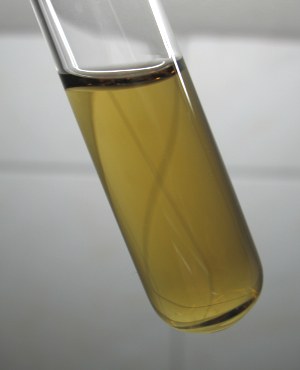

Silver in high oxidation state
It is well known that silver exists as Ag+ ions in its salts. These silver(I) ions are colorless and hence solutions of silver(I) salts usually are colorless, unless the associated cation has a color. In high school books this is the only silver ion which is discussed. But silver is capable of forming higher oxidation state compounds. The metal also can exist in the +3 oxidation state.
The ion Ag3+ is not very stable, but it can exist in aqueous solution at very low pH, coordinated to nitrate ions or nitric acid. In neutral solutions it quickly hydrolyses and there is partial oxidation of water and at the same time it forms a mixed oxide, Ag2O2, which contains silver in oxidation state +1 and oxidation state +3.
The Ag3+ ion appears to be unstable in other than nitric acid solutions. The color also is much weaker in other than nitric acid solutions.
![]()
![]() Required
chemicals:
Required
chemicals:
-
silver nitrate
-
potassium peroxodisulfate (or the sodium salt)
-
sodium hydroxide
-
concentrated nitric acid (50+ %)
-
hydrogen peroxide (3%)
-
perchloric acid, max. 70% (optional for additional experiment)
-
silver(I) oxide (optional for additional experiment)
![]() Required
equipment:
Required
equipment:
-
100 ml beaker
-
glass rod
-
alcohol burner or heater
-
filter paper and tissue
![]() Safety:
Safety:
- Silver nitrate is fairly toxic and fairly corrosive. It gives black stains on the skin. If you get black stains, you simply have to wait, until they disappear by wear. This may take a week or something like that.
- Concentrated nitric acid is very corrosive. Avoid contact with skin. If some acid accidently is spilled on skin, then immediately rinse with a lot of water. Contact with the acid for more than a few tens of seconds leads to a yellow coloration of the skin and it may take a week or so before such stains disappear. Longer contact (a few minutes) will lead to chemical burns.
- Perchloric acid (max. 70% by weight) is highly acidic but non-oxidizing at room temperature. It is corrosive, but not as corrosive as concentrated nitric acid. Avoid contact with skin. If there is accidental contact, then quickly rinse with a lot of water.
- Sodium hydroxide is very corrosive. It slowly dissolves skin. If some of this is spilled on the skin, then the skin feels slippery, as if it is covered by wet soap. If this happens then rinse the skin under running water, until the slippery feeling has gone.
![]() Disposal:
Disposal:
- The liquid waste, produced in this experiment, can be flushed down then drain. It only contains minor quantities of silver. The filter paper, used in this experiment, most likely will have some silver(I,III) oxide sticking to it. It is best to allow this to dry and then treat it as small chemical waste.
![]()
Procedure for performing the experiment
![]() Take
approximately 2.5 grams of solid potassium peroxodisulfate (or 2.2 grams of
solid sodium peroxodisulfate). Put the solid in a 100 ml beaker and add 50 ml of
distilled water. Heat the liquid until it is near boiling. Stir while heating.
The potassium peroxodisulfate dissolves and gives a clear and colorless
solution.
Take
approximately 2.5 grams of solid potassium peroxodisulfate (or 2.2 grams of
solid sodium peroxodisulfate). Put the solid in a 100 ml beaker and add 50 ml of
distilled water. Heat the liquid until it is near boiling. Stir while heating.
The potassium peroxodisulfate dissolves and gives a clear and colorless
solution.
![]() Take
approximately 2.5 grams of sodium hydroxide and add 5 ml of distilled water.
Allow the solid to dissolve (beware, quite some heat is produced). Add this
solution to the solution of potassium peroxodisulfate while stirring. Keep on
heating the beaker with almost 60 ml of solution and stir occasionally.
Take
approximately 2.5 grams of sodium hydroxide and add 5 ml of distilled water.
Allow the solid to dissolve (beware, quite some heat is produced). Add this
solution to the solution of potassium peroxodisulfate while stirring. Keep on
heating the beaker with almost 60 ml of solution and stir occasionally.
![]() Dissolve approximately 1.5 grams of silver nitrate in 10 ml
of water. Slowly add this solution of silver nitrate to the beaker with the hot
solution of potassium peroxodisulfate and sodium hydroxide while stirring. When
this is done, a dark brown precipitate is formed. This precipitate quickly turns
grey/black and the particles become larger, such that it settles to the bottom
very quickly.
The result looks as follows:
Dissolve approximately 1.5 grams of silver nitrate in 10 ml
of water. Slowly add this solution of silver nitrate to the beaker with the hot
solution of potassium peroxodisulfate and sodium hydroxide while stirring. When
this is done, a dark brown precipitate is formed. This precipitate quickly turns
grey/black and the particles become larger, such that it settles to the bottom
very quickly.
The result looks as follows:
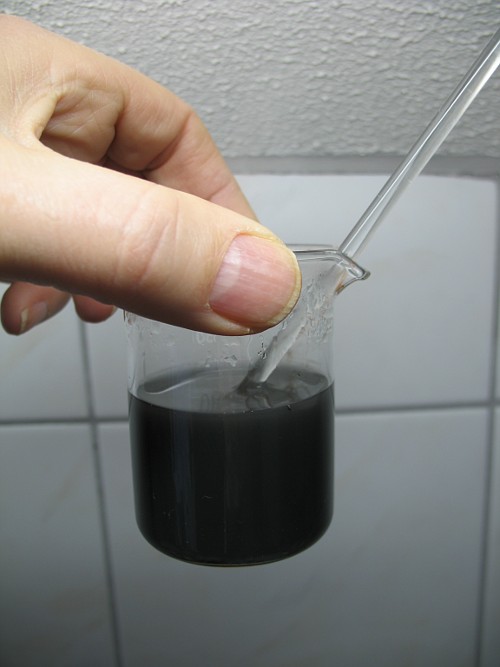
![]() Keep
stirring the beaker with the nearly black precipitate for 5 minutes or so, while
the liquid is kept near the boiling point of water. While doing so, there will
be slow production of bubbles from the solution. After 5 minutes stop heating.
The heating makes the precipitate more dense and during heating the liquid
becomes more transparent. After 5 minutes the precipitate is so compact that it
settles to the bottom in seconds while leaving a grey partially transparent
liquid above the black precipitate:
Keep
stirring the beaker with the nearly black precipitate for 5 minutes or so, while
the liquid is kept near the boiling point of water. While doing so, there will
be slow production of bubbles from the solution. After 5 minutes stop heating.
The heating makes the precipitate more dense and during heating the liquid
becomes more transparent. After 5 minutes the precipitate is so compact that it
settles to the bottom in seconds while leaving a grey partially transparent
liquid above the black precipitate:
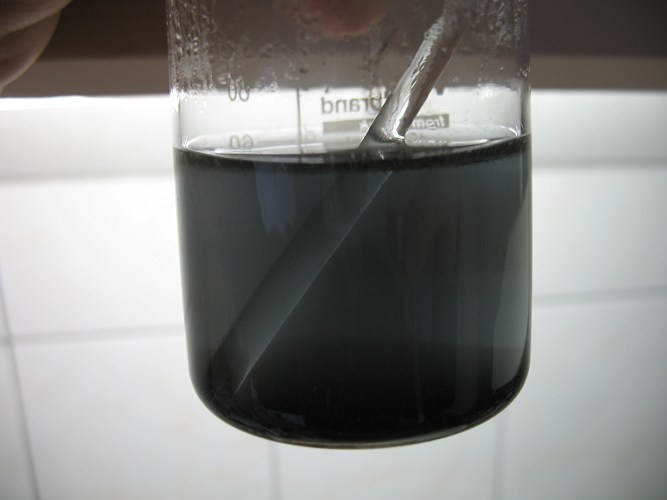
![]() Decant
the grey liquid from the black solid. The grey liquid contains very fine solid
particles, but the amount of silver in this liquid is very low, probably less
than 1% of all silver used in this experiment. After decanting the grey liquid
the wet precipitate remains in the beaker and the mechanical losses can be kept
nearly zero:
Decant
the grey liquid from the black solid. The grey liquid contains very fine solid
particles, but the amount of silver in this liquid is very low, probably less
than 1% of all silver used in this experiment. After decanting the grey liquid
the wet precipitate remains in the beaker and the mechanical losses can be kept
nearly zero:
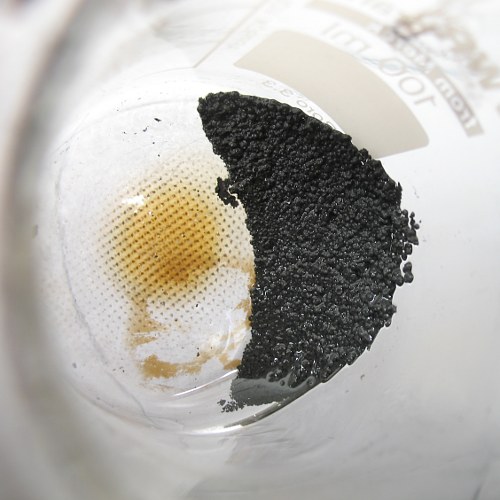
![]() Add 20 ml of distilled water and swirl the beaker for half a
minute. Immediately after stopping with the swirling, the precipitate settles
and a clear liquid with a faint brown/grey color remains:
Add 20 ml of distilled water and swirl the beaker for half a
minute. Immediately after stopping with the swirling, the precipitate settles
and a clear liquid with a faint brown/grey color remains:
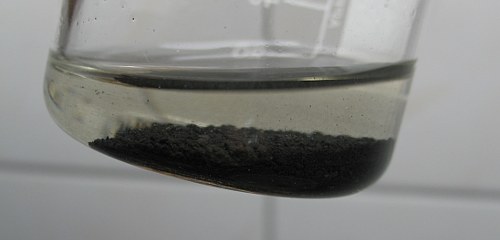
Decant the liquid and keep the precipitate. The above rinsing procedure must be repeated until the liquid above the precipitate is completely clear. This requires three or four rinses.

The picture above shows the result after 3 rinses. The liquid is clear, but small black specks are in the liquid. The latter is not a real problem. Just let them settle and then decant the liquid.
![]() After
three or four rinses with 20 ml of distilled water transfer all of the solid
material to a filter paper, which in turn is placed on a pile of paper tissues.
Allow the filter with the black solid mass to sit on the pile of paper tissues
for 5 minutes or even 10 minutes, depending on the type of filter paper and type
of paper tissue. After this period, when the solid on the filter looks fairly
dry, take the filter paper with the solid and put it in a warm place for several
hours, until the material is totally dry.
After
three or four rinses with 20 ml of distilled water transfer all of the solid
material to a filter paper, which in turn is placed on a pile of paper tissues.
Allow the filter with the black solid mass to sit on the pile of paper tissues
for 5 minutes or even 10 minutes, depending on the type of filter paper and type
of paper tissue. After this period, when the solid on the filter looks fairly
dry, take the filter paper with the solid and put it in a warm place for several
hours, until the material is totally dry.
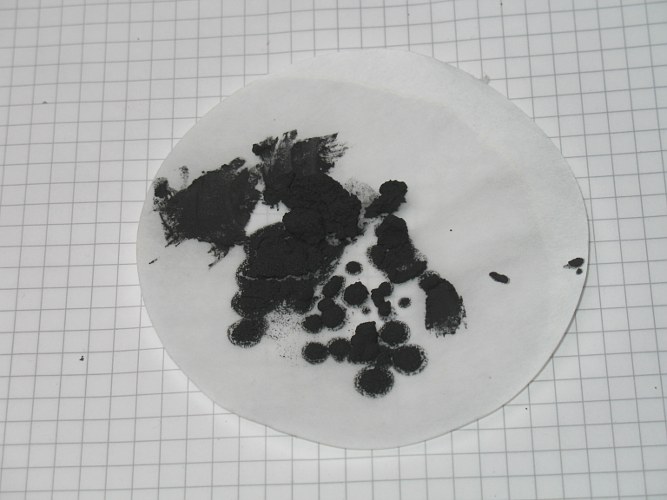
Halfway it may be necessary to crunch the pieces which are transferred to the filter paper. Do not transfer the solid mass from the beaker to a piece of paper tissue directly. If this is done, then most of the solid will be lost, because it will be impossible to scrape it away from the paper tissue. Use real filter paper. Even coffee filter can be used.
When the solid is thoroughly dry, then the material looks dark grey. The dark grey solid can easily be scraped from the filter paper and the larger pieces can easily be crunched somewhat. Unfortunately, there will be some losses. Part of the solid sticks to the filter paper and this must be considered as lost. Do not try to scrape every last little piece of solid from the filter paper. You probably get more fibers from the filter paper than solid Ag2O2.
The final product is put in a vial:
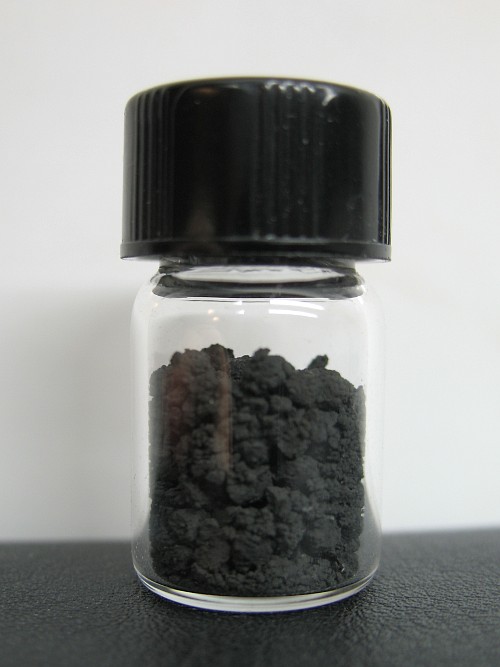
Total yield is 0.9 grams, which is approximately 80% of theory. The main loss is on the filter paper and there are minor losses in the rinsing and decanting processes. The chemical reaction itself has nearly quantitative yield and it is expected that on scaling up of this reaction the yield will go up.
![]()
Some basic properties of Ag2O2 , also written as AgIAgIIIO2
The solid mixed oxide is an interesting compound with some special properties. It is a very strong oxidizer. It does not dissolve in water, but it easily dissolves in moderately concentrated nitric acid (appr. 50% by weight) and these solutions have a very intense brown color.
A nice demonstration of this can be given by dissolving a tiny speck of solid. The picture below shows the amount to be dissolved, in a standard 160 mm length test tube.
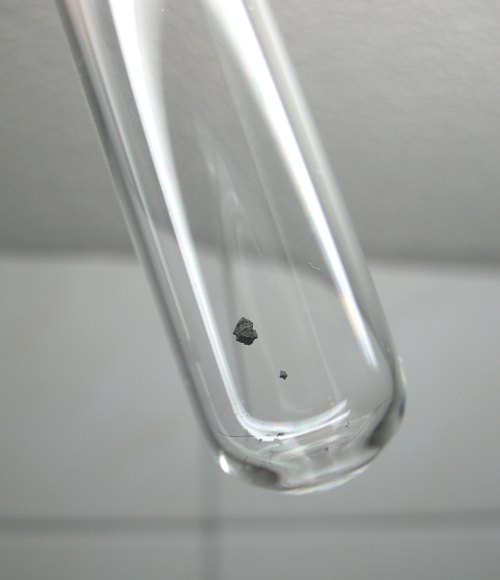
When a small quantity of 50% nitric acid is added, then the solid quickly dissolves. The solution is dark brown. The two pictures below show the result of dissolving the small speck of solid in 50% HNO3.
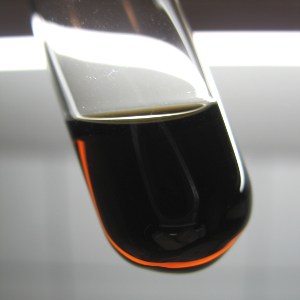
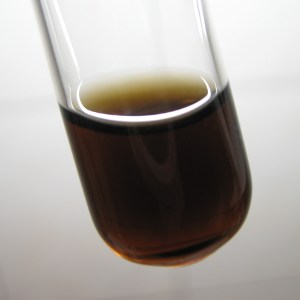
On dilution, a more yellowish color is obtained:
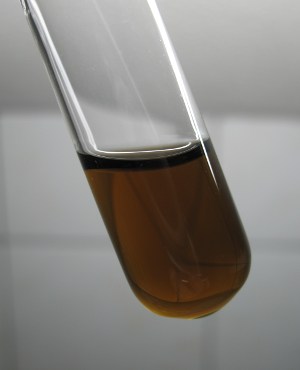

When a few drops of hydrogen peroxide are added, then the liquid at once becomes completely colorless. The silver(III) ions are reduced by the hydrogen peroxide to silver(I).
When a more concentrated solution is prepared then one can see how strong the color is. The picture below shows a solution, prepared by dissolving a 5 mm pile of solid in 50% HNO3.
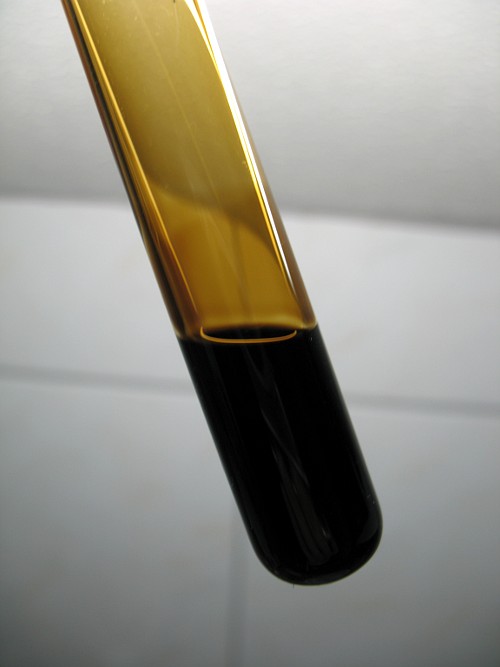
This solution still is quite dilute, it is just a 4 to 5 mm height pile of very loosely packed powder, probably just a few tens of mg. The picture shows that the liquid is nearly black and when the liquid sticks to the glass it gives a strong color.
![]()
Using perchloric acid instead of nitric acid
When some Ag2O2 is added to 60% perchloric acid, then the solid quickly dissolves, while fizzling, and a pale pink/brown solution is obtained. When two drops of 50% nitric acid are added, then the liquid becomes dark brown again, like in the pictures above.
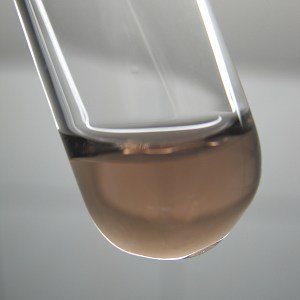
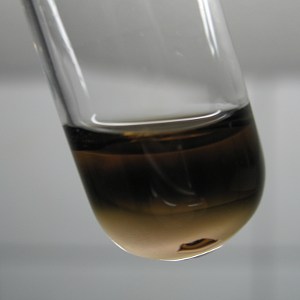
The left picture above shows the result of adding some Ag2O2 to 60% perchloric acid, after the fizzling has ceased and the situation has stabilized. The right picture shows the same test tube, with 2 big drops of nitric acid added, without swirling.
The right picture nicely shows that where the nitric acid is mixed with the perchloric acid layer, a dark brown compound is formed, while near the surface and near the bottom the liquid is lighter. When the test tube is swirled, then the contents becomes dark brown in all of the liquid.
The question now is, is the pale pink/brown color due to the presence of some left over nitrate in the Ag2O2, used in the experiment? The Ag2O2 was made from silver nitrate and although the precipitate was rinsed well several times, one can imagine that still some nitrate is left in the precipitate. For this reason, a final experiment was done in which no nitrate is involved at all.
![]()
Final experiment with preparation of silver(I,III) oxide from silver(I) oxide
In order to be sure that no nitrate is present, the following experiment was performed:
![]() Dissolve
some silver(I) oxide from a commercial supplier in a small amount of 50%
perchloric acid. This results in formation of a colorless liquid. Dilute this
liquid with 5 times its volume of distilled water.
Dissolve
some silver(I) oxide from a commercial supplier in a small amount of 50%
perchloric acid. This results in formation of a colorless liquid. Dilute this
liquid with 5 times its volume of distilled water.
![]() In
another test tube, prepare a solution of sodium hydroxide and sodium
peroxodisulfate and heat this liquid until it is hot (well below boiling, but so
hot that one cannot bear touching the test tube containing the solution). Add
this liquid to the solution, containing the dissolved silver(I) oxide. When this
is done, then a fine dark brown/grey precipitate is formed. So much NaOH and
sodium peroxodisulfate are used that both reagents are present in excess
amounts.
In
another test tube, prepare a solution of sodium hydroxide and sodium
peroxodisulfate and heat this liquid until it is hot (well below boiling, but so
hot that one cannot bear touching the test tube containing the solution). Add
this liquid to the solution, containing the dissolved silver(I) oxide. When this
is done, then a fine dark brown/grey precipitate is formed. So much NaOH and
sodium peroxodisulfate are used that both reagents are present in excess
amounts.
![]() Heat the
test tube with the dark precipitate such that it just becomes below boiling and
keep it at that temperature for 5 minutes. When this is done, then the
precipitate becomes dark grey and much coarser, such that it settles at the
bottom at once.
Heat the
test tube with the dark precipitate such that it just becomes below boiling and
keep it at that temperature for 5 minutes. When this is done, then the
precipitate becomes dark grey and much coarser, such that it settles at the
bottom at once.
![]() Rinse
the precipitate three times with distilled water and split in two parts.
Rinse
the precipitate three times with distilled water and split in two parts.
One part of the precipitate is added to 65% nitric acid. This results in a very dark brown solution, just like the one shown above.
The other part of the precipitate is added to 70% perchloric acid. This results in a very pale pink/brown solution and a lot of fizzling. After the fizzling stops, the final solution looks as follows:
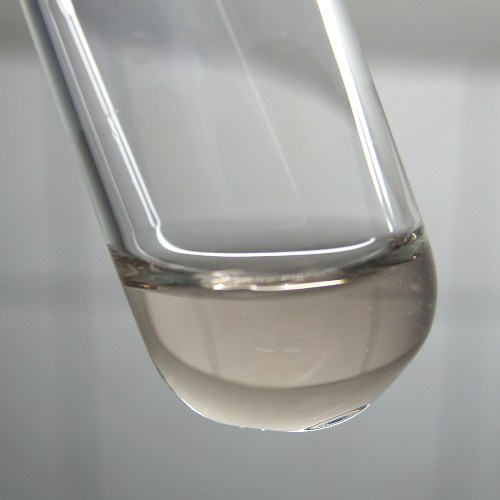
When a few drops of 65% nitric acid are added to this liquid, then the liquid turns darker, but it does not become as dark as when the same amount of Ag2O2 is added to 65% nitric acid.
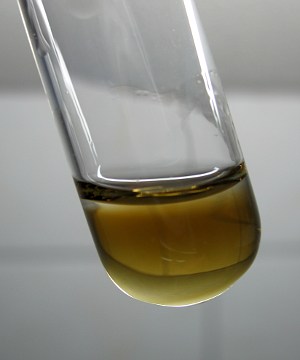
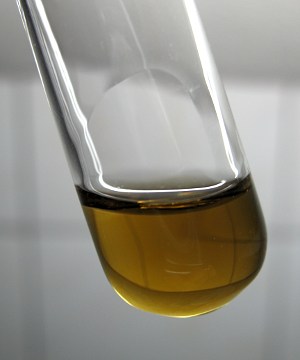
The left picture above shows the effect of adding some 65% nitric acid and the right picture shows the same test tube after swirling.
This experiment, together with all the experiments above, demonstrates that the presence of nitric acid really is important for getting the dark brown color. This final experiment also shows that when no nitric acid or nitrate is available, then most of the silver(III) is reduced on dissolving the Ag2O2 in acid.
![]()
Discussion of results
![]() Peroxodisulfate ion is a very strong oxidizer and this is capable of oxidizing
silver(I) ions to silver(III) according to the following net equation:
Peroxodisulfate ion is a very strong oxidizer and this is capable of oxidizing
silver(I) ions to silver(III) according to the following net equation:
Ag+ + S2O82– + OH– → Ag2O2 + SO42– + H2O
Not all of the silver is oxidized to silver(III). Silver(I) and silver(III) combine to give an insoluble oxide in alkaline solution and the silver(I) is locked up in this oxide, such that it is not oxidized.
If this reaction is carried out in strongly acidic solution, then the liquid turns dark brown and remains clear, due to formation of silver(III) ions.
![]() In very strongly acidic solutions, Ag2O2
dissolves, giving Ag3+ ions and Ag+ ions:
In very strongly acidic solutions, Ag2O2
dissolves, giving Ag3+ ions and Ag+ ions:
Ag2O2 + 4H+ → "Ag3+" + Ag+ + 2H2O
In the presence of nitric acid, the silver(III) forms a very dark brown compound, which remains in solution. In other acids, the silver(III) is mostly destroyed. It oxidizes water in the solution, forming oxygen while itself being converted to silver(I).
![]() The ion Ag3+ is a very strong oxidizer. It
is capable of oxidizing hydrogen peroxide at once:
The ion Ag3+ is a very strong oxidizer. It
is capable of oxidizing hydrogen peroxide at once:
"Ag3+" + H2O2 → Ag+ + 2H+ + O2
The notation " " is used to indicate that the ion is not really free Ag3+, but a coordination complex of Ag3+. The nitric acid is essential for the appearance of the very dark brown color. With other acids, this color does not appear.
The nature of the dark brown complex in nitric acid is not clear to me. It most likely is a silver(III) compound, it might be a silver(II) compound, but it definitely contains silver in a higher than +1 oxidation state. It also most likely has HNO3 coordinated to it and not NO3–. It only exists in concentrated acids, where there is undissociated HNO3.